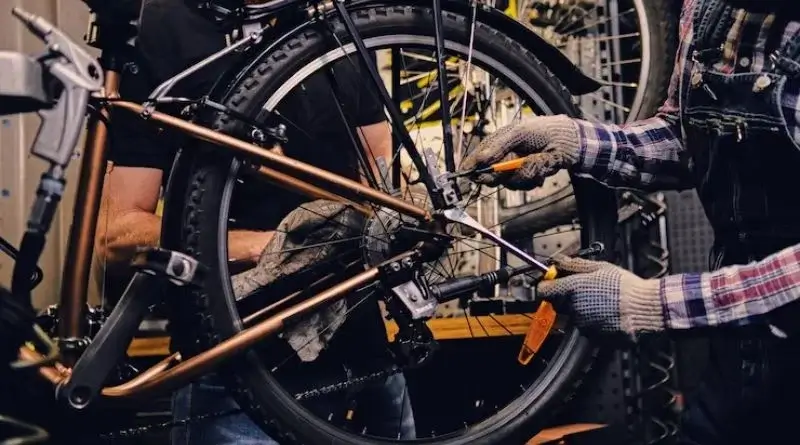5 Bicycle Maintenance Hacks You Can Do at Home
Bicycles are an excellent mode of transportation because they provide us with exercise, independence, and adventure. To ensure optimal performance and longevity, bicycles require regular maintenance, just like any other machine. Despite the availability of professional bike repair services, there are several easy maintenance hacks for bike repair at home. In this blog, we will discuss five bicycle maintenance hacks that will maintain your bike in tip-top condition. These tips are helpful whether you own an Electronic bicycle, a mountain bike, or any other bicycle.
1. Keep Your Chain Clean and Lubricated
- The chain is one of the most important parts of a bicycle, as it transfers momentum from your legs to the wheels. A soiled and dried chain can inhibit performance and hasten wear. Regularly clean and lubricate your chain to maintain it operating smoothly.
- Start by removing any debris and grime with a degreaser. Apply the degreaser to a brush or cloth and scrub the chain thoroughly, ensuring you reach every link. After cleaning the chain, flush it with water and pat it dry with a clean cloth.
- After cleaning the bicycle chain, apply a suitable lubricant to each link while rotating the pedals in reverse. Allow the lubricant to absorb for a few minutes before wiping away any excess. This straightforward maintenance task will improve your bicycle’s shifting performance and extend its chain life.
2. Check and Adjust Brakes
- The functionality of your brakes is crucial to your well-being while riding. Inspecting and adjusting your brakes at home regularly will help preserve their effectiveness.
- Examine the brake pads for signs of degradation to get started. They must be replaced if worn down to the indicator line or have a thickness of less than 3 mm. Verify the brake pads are properly aligned and make uniform contact with the rim or disc.
- Adjust the brake tension if your brakes feel sluggish despite having excellent brake pads. An adjusting barrel on the majority of brakes is near the brake mechanism. Turn it anticlockwise to decrease tension and clockwise to increase it. Test the brakes after minor adjustments until they engage effortlessly and without excessive force.
3. Check and Inflate Tyres
- Maintaining the correct tyre pressure is necessary for smooth and efficient travel. Examine your tyres frequently for signs of wear, cuts, or punctures. Additionally, inspect the tyre sidewalls for fractures or bulges, as these indicate replacement is necessary.
- For tyre inflation, utilise a floor compressor with a pressure gauge. Typically, the recommended tyre pressure is imprinted on the tyre sidewall. Inflate the tyres to the specified pressure, inflating both tyres evenly.
- Maintaining appropriate tyre pressure reduces the risk of flats and enhances your bicycle’s handling and performance across various terrains.
4. Ensure Proper Gear Shifting
- Shifting gears smoothly is essential for a pleasurable cycling experience, particularly when traversing difficult terrains on a mountain bike. To guarantee proper gear shifting, execute the following:
- Check the transmission cable tension first. Use the barrel adjuster near the lever or rear derailleur to fine-tune the cable tension if shifting feels sluggish. Turn it clockwise to loosen the cable and anticlockwise to secure it.
- Next, apply a small quantity of bicycle-specific lubricant to the exposed sections of the gear cables to lubricate them. While pedalling, shift through the gears to enable the lubricant to penetrate the cable housing.
- Check the alignment of the rear derailleur as a final step. Ensure it is properly aligned with the cassette and does not rub against any cogs. Use the barrel adjuster to make minor adjustments to the derailleur’s position, if necessary. These procedures will optimise your gear shifting, ensuring a more efficient and comfortable commute.
5. Check and Tighten Nuts and Bolts
- Regularly scrutinising and tightening bicycle bolts and nuts prevents components from becoming loose and causing accidents. Check the tightness of bolts on the stem, handlebars, seatpost and pedals using a torque wrench or other suitable instruments.
- Ensure that the quick-release mechanisms on the wheels are properly tightened and that the wheels are attached to the frame securely. Loose fasteners can result in wobbling, instability, or even component failure, so it is essential to inspect them periodically.
Home bicycle maintenance is both cost-effective and empowering. These five bicycle maintenance tips can keep your bike running smoothly and lengthen its lifespan. Remember to clean and lubricate your chain, check and adjust your brakes, inspect and inflate your tyres, ensure proper gear shifting and routinely check and tighten your fasteners. By maintaining your bicycle, whether an e-bicycle, a mountain bike, a city cycle, or any other type, you will enjoy safer and more pleasurable rides for many years. Another benefit of cycle repair at home is saving money. Easy tips and tricks can save money spent on repairing professionals. Happy cycling!



